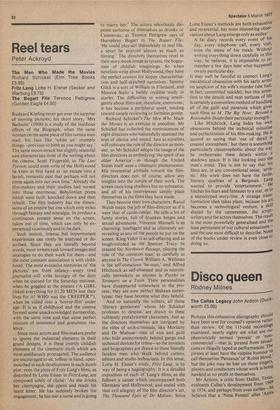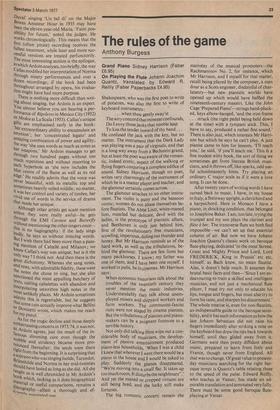Disco queen
Rodney Milnes
The Callas Legacy John Ardoin (DuCkworth £5.95) Perhaps this exhaustive discography should have been sent for counsel's opinion rather than review. Of the 115-odd recordings examined, nearly eighty are what are euphemistically termed 'private' or 'noncommercial'—that is, pirated from broadcasts or illegally taped at performances. The pirates at least have the vulpine humour to, call themselves 'Penzance' or 'Robin Hood, but the joke may be lost on those singers, players and conductors whose work is being hawked at no profit to themselves. Mr Ardoin, a critic from Dallas, Texas, evaluates Callas's development from 1949 to 1974, and perhaps from even earlier—he believes that a 'Nina Foresti' alias .Anita
Duval' singing 'lin bel di' on the Major Bowes Amateur Hour in 1935 may have been the eleven-year-old Maria. 'Faint pos sibility for future,' noted the judges. He Works chronologically. This means that the first (often pirate) recording receives the fullest treatment, while later and more successful versions are treated perfunctorily. The most interesting section is the epilogue, in which Ardoin analyses, too briefly, the way Callas modified her interpretation of Norma through ninety performances and over a dozen recordings; if the book had been throughout arranged by opera, his evaluation might have had more purpose.
There is nothing more difficult than writing about singing, but Ardoin is an expert. You almost believe you are hearing a performance of Rigoktto in Mexico City (1952) or Medea at La Scala (1953). Callas's unique
gifts are emphasised early in the book : 'her extraordinary ability to encapsulate an
emotion'; her 'concentrated legato' and amazing combination of power and agility; the way 'she uses words as much as notes as herw — through Mr Ardoin manages to get ug,, 1 two hundred pages without too much repetition and without resorting to
such hyperbole as 'she now includes the blue centre of the flame as well as its red edge.' He readily admits that the voice was
never beautiful, with its metallic top and sometimes heavily veiled middle; no matter, it was her control and variety of timbre, her vivid use of words in the service of drama that made her unique.
Although other artists get scant mention unless they were really awful—he gets
through the EMI Carmen and Butterfly
Without mentioning the other singers once— this is no hagiography: if the lady sings
badly, he says so without mincing words.
But I wish there had been more than a passing mention of Caballe and Milanov; we
know Callas's way was unique, but is it the Only Way? I think not. And then there is the great dichotomy. Whereas she sang notes,
and rests, with admirable fidelity, these were
the notes she chose to sing, but she also sanctioned the most appalling butchery of !ems, cutting cabalettas with abandon and Interpolating unwritten high notes in the most unlikely places. Mr Ardoin sometimes admits this is regrettable, but he suggests that some cuts actually improve what Bell ini Or Donizetti wrote, which makes me reach for my pistol. As for the tragic decline and those deeply embarrassing concerts in 1973/74, it was not, as Ardoin agrees, just the result of the in
famous slimming cure even though the `wobble and stridency became more pro nounced thereafter: the seeds were there
rig“t from the beginning. It is surprising that a_ soprano who was singing lsolde, Turandot. BrUnnhilde and Norma in her mid-twenties ,should have lasted as long as she did. All she langht us is well chronicled in Mr Ardoin's book which, lacking as it does biographical material or useful comparisons, remains a Alsc. °graPhy—albeit a thorough and ef''nflv annotated one.



































 Previous page
Previous page